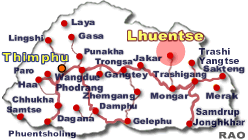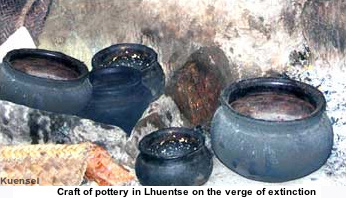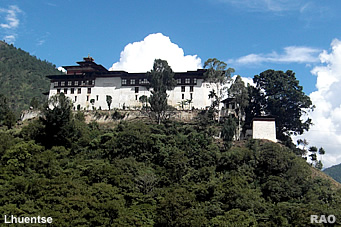 |
Bhutan's
Economy |
|
 |
Bhutan Information |
|
|
 |
| Pottery
making survives in Gangzur |
 |
 |
| In
the absence of a market for Bhutanese handmade earthern pots, and competition
from ready-made imports, the traditional craft of pottery making in Bhutan
is on the verge of extinction.
But
in Gangzur Lhuentse, it still survives in the hands of two women
who continue to practise this ancient tradition. |
|
Tshering
Zangmo and her friend Tshewang who are in their mid 30s make about 20 pots
of different designs, some as small as a teacup used to burn incense to
the biggest, about three feet in height, used to brew ara or local liquor.
"There are five different types, each having its own specific utility,"
said Tshering Zangmo, 35, who has been making pots for the past 15 years.
 |
| During
winter when there is no work in the fields, the two women collect the red
and yellow sandy clay from the hill in front of their house and manually
make the earthen pots. They do not use a spinning lathe.
Once
stones and other granules are removed from the clay it is kneaded and beaten
into malleable dough. The pots are shaped on a thatched wooden plank. |
|
The
inside of the clay ball is gouged out and the rough shell is left to dry
for a week. The pot are then put in a fire to make them firm and durable.
During
winter when there is no work in the fields, the two women collect the red
and yellow sandy clay from the hill in front of their house and manually
make the earthen pots. They do not use a spinning lathe.
Once
stones and other granules are removed from the clay it is kneaded and beaten
into malleable dough. The pots are shaped on a thatched wooden plank. The
inside of the clay ball is gouged out and the rough shell is left to dry
for a week. The pot are then put in a fire to make them firm and durable.
Every
month villagers from other geogs in Lhuentse buy pots from the two women.
 |
| People from other parts of the country and foreigners who visit the village
to see the two at work also buy their products. "In a month we earn
about Nu. 500," said Tshering Zangmo. "It is enough to pay the land and
livestock tax, house insurance and to buy vegetable oil, sugar and salt.
Tshering
Zangmo said that during the monsoon, the soil gets deprived of its sticky
natural glue and is therefore unsuitable to make pots. "That is when we
get busy in the fields," said Tshewang. |
|
Two
years back Tshering and Tshewang sold five pots regardless of their sizes
for just one Ngultrum until the dzongkhag officials advised them to raise
the rates "We now sell a pot for about Nu. 45 each," said Tshewang.
The
two women said the number of buyers had dropped with time. Their main customers
are now villagers from Khoma who bought the oversize pots to brew ara while
a few government officials and visitors bought the smaller ones.
The
people of Gangzur have no knowledge of how old the pottery tradition is
but Tshering Zangmo says that not very long ago people from eight geogs
under Lhuentse used earthen pots to cook food, brew ara, and store water.
One
of the traditional Bhutanese crafts, pottery is on the verge of extinction
in Paro and has completely disappeared in the villages above Khasadrapchu
in Thimphu. "The entire village used to make earthen pots in the past,"
said Tshering Zangmo.
| Contributed
by Samten Wangchuk,KUENSEL, Bhutan's National Newspaper |
 |
|
more information |
 |
|





